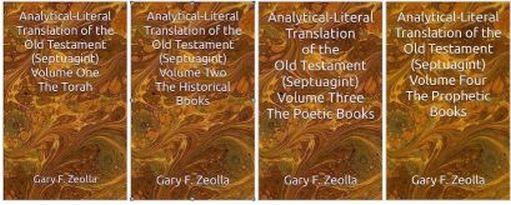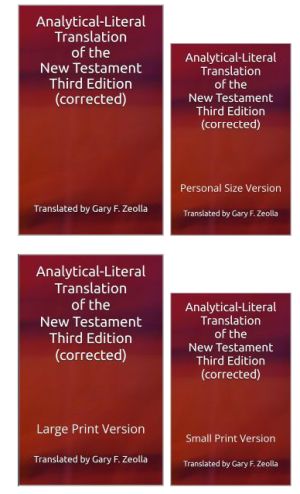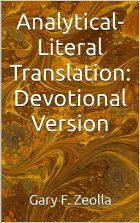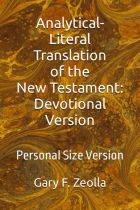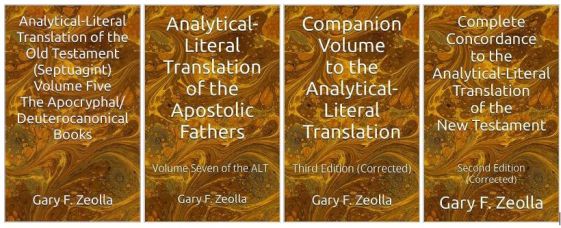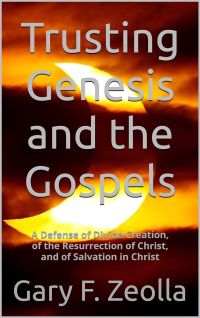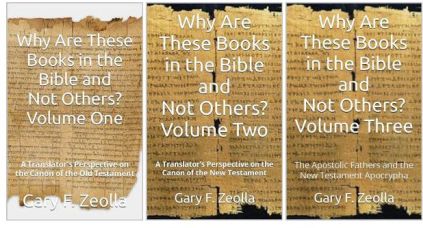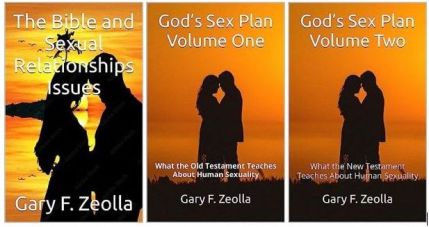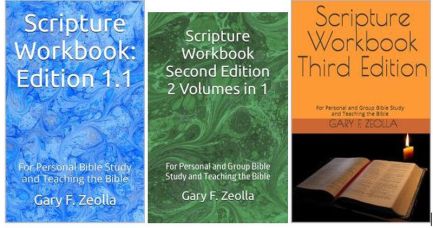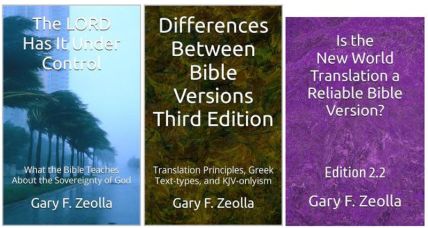Books and eBooks by the Director
The following 22 books are by Gary F. Zeolla, the director of Darkness to Light Christian Ministry. The books are grouped by related books, as seen in the top directory. Click on the title link for further details, available formats, and purchasing information. Click any picture for a larger image. The links to Amazon are advertising links, for which I receive a commission in addition to my royalty if a product is purchased after following the link.
Analytical-Literal Translation of the Old Testament
Analytical-Literal Translation of the New Testament
Analytical-Literal Translation of the NT: Devotional Version
Defense of Christian Doctrines and Ethics
How Were the Books of the Bible Chosen?
Analytical-Literal Translation of the Old Testament
The Analytical-Literal Translation of the Old Testament (ALT: OT) is available in four volumes. This Old Testament is based on the Greek Septuagint (LXX). The LXX is a third century B.C. Greek translation of the Hebrew Bible. This ALT: OT will enable the reader to come as close to the Greek text as possible without having to be proficient in Greek.
Analytical-Literal Translation of the Old Testament (Septuagint) - Volume One - The Torah
Analytical-Literal Translation of the Old Testament (Septuagint) - Volume Two - The Historical Books
Analytical-Literal Translation of the Old Testament (Septuagint) - Volume Three - The Poetic Books
Analytical-Literal Translation of the Old Testament (Septuagint) - Volume Four - The Prophetic Books
See also this series on Amazon.
Analytical-Literal Translation of the New Testament
The Analytical-Literal Translation of the New Testament: Third Edition (corrected) (ALT3c) is the only New Testament that is a literal translation of the second edition of the Byzantine Majority Greek Text, brings out nuances of the Greek text, and includes study aids within the text. ALT3c promotes understanding of what the New Testament writers originally wrote. Available in multiple hardcopy and eBook formats.
Analytical-Literal Translation of the New Testament: Third Edition (corrected) (ALT3c)
See also this series on Amazon.
Analytical-Literal Translation of the NT: Devotional Version
The main difference between ALTD and ALT3 is that in the ALTD the “analytical” information is footnoted, while in ALT3 such information is included within brackets within the text. By putting this information in footnotes, ALTD is a much easier to read and to quote from version. Available in multiple hardcopy and eBook formats.
Analytical-Literal Translation of the New Testament: Devotional Version (ALTD)
See also this series on Amazon.
If you are getting an eBook version, you might be better off with ALT3. But if you are getting a hardcopy version, you might prefer the Devotional Version.
Additional ALT Books
The following books are related to the ALT. The first contains the “extra” books found in Roman Catholic and Eastern Orthodox Bibles as compared to Jewish and Protestant Bibles. The second includes translations of books that would be considered to be an “appendix” to the New Testament. The final two are study aids for the ALT.
Analytical-Literal Translation of the Apostolic Fathers: Volume Seven of the ALT (ALT: APF)
Complete Concordance to the ALT New Testament
See also this series on Amazon.
Defense of Christian Doctrines and Ethics
More books in this series forthcoming!
How Were the Books of the Bible Chosen?
Why are the 66 books in the Bible in the Bible, and why were other books that could have been included not included? Are these books reliable:? This three-volume set answers these and many related questions.
See also this series on Amazon.
Sex and the Bible
These three books address the many hot button issues related to sexuality in our culture today: from abortion to transsexualism to sexual harassment and assault to men competing in women’s sports.
Also covered are homosexuality and same-sex marriage, premarital sex (fornication), extramarital sex (adultery), monogamy, marital sex, polygamy, incest, celibacy, reproduction, infertility, contraception, masturbation, pornography, gender roles, and school and other mass shootings (yes, those are related to this topic).
The first book is an introduction to the various subjects, quoting the most relevant Scriptures, with only short commentary. The next two books are much more detailed, with many more Scripture passages quoted and much more detailed commentary.
The Bible and Sexual Relationships Issues
God’s Sex Plan: Volume One: What the Old Testament Teaches About Human Sexuality
God’s Sex Plan: Volume Two: What the New Testament Teaches About Human Sexuality
See also this series on Amazon.
Scripture Workbooks
The doctrinal and ethical teachings of the Bible as presented in these books encompass an overall way of viewing the world that differs greatly from the prevailing secular worldview. It is hoped these books will enable the reader to not only understand this Biblical worldview but also why it is true and thus to come to trust in it, and then to be prepared to defend this Biblical worldview before an unbelieving world (Luke 24:27,45; Acts 14:14-18; 17:22-31). The most recent and comprehensive is the first book listed.
Scripture Workbook, Third Edition: For Personal and Group Bible Study and Teaching the Bible
Scripture Workbook: For Personal Bible Study and Teaching the Bible: Second Edition
Scripture Workbook: For Personal Bible Study and Teaching the Bible: Edition 1.1
See also this series on Amazon.
Bible Study and Versions
The first book is for the person struggling in life and for the person struggling with how God sovereignly works in people’s lives. The second answers questions such as: Why do Bible versions differ? Why does the same verse read differently in different versions? Why do some versions contain words, phrases, and even entire verses that other versions omit? Which Bible versions are the most reliable? The third book answers the question posed by the title.
The LORD Has It Under Control: What the Bible Teaches About the Sovereignty of God
Differences Between Bible Versions: Third Edition
Is the New World Translation a Reliable Bible Version? Edition 2.2
See also this series on Amazon.
Fitness and Politics Books
I have many additional books available, but they are health and fitness-related or politics related. The health/ fitness books are described on the books section of my Fitness for One and All Web site. The political books are described on the books section of my Biblical and Constitutional Politics website.
Publisher Author
Pages
(all books by Gary F. Zeolla)
![]() Subject Index
Subject Index
![]() Text
Search
Text
Search
![]() Alphabetical List of
Pages
Alphabetical List of
Pages ![]() Contact
Information
Contact
Information

